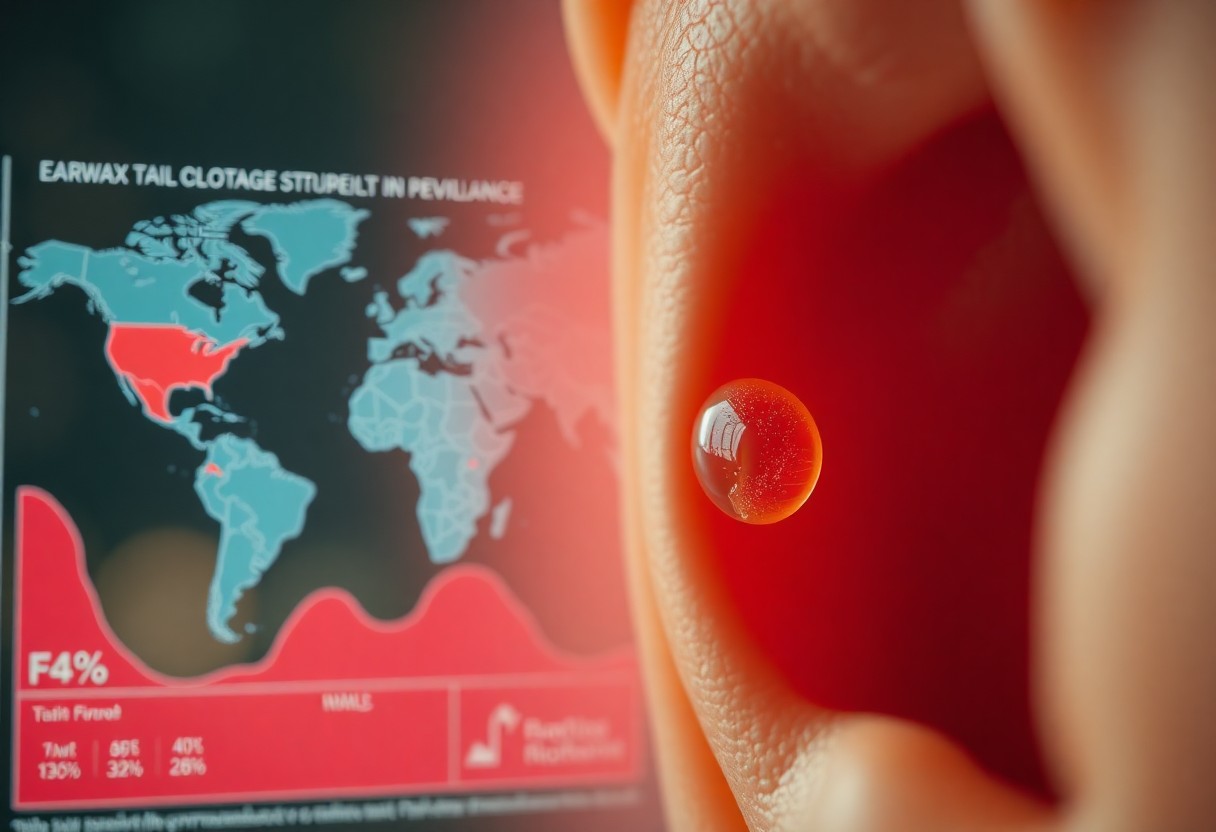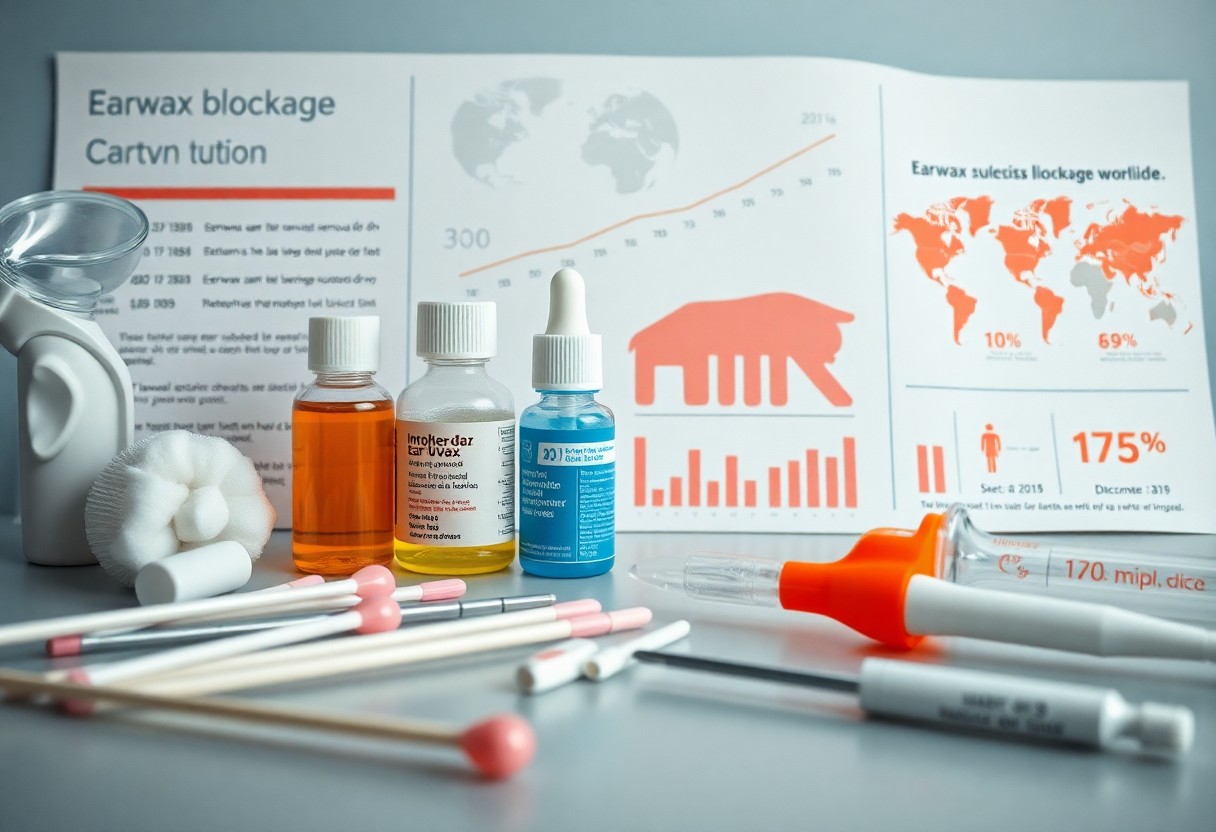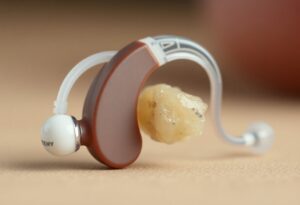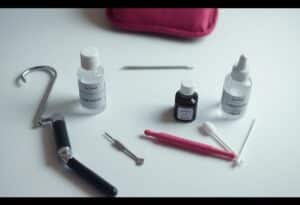You may be surprised to learn that earwax blockage is a common issue affecting millions of people globally. Studies indicate that up to 10% of adults experience blockages, often leading to discomfort and hearing loss. This informative post will explore earwax removal statistics, highlighting the prevalence of this condition across different demographics and the importance of proper ear care. By understanding the scope of earwax-related issues, you can better appreciate the need for effective prevention and treatment strategies.

Key Takeaways:
- Epidemiological studies suggest that around 10% of the global population experiences earwax blockage at some point in their lives.
- Blockage rates may increase with age, affecting up to 30% of older adults.
- Factors such as ear health, hygiene practices, and genetic predisposition can influence the prevalence of earwax blockage.
The Global Prevalence of Earwax Blockages
Statistical Overview of Earwax Blockages by Region
Earwax blockage prevalence varies by region, influenced by factors such as climate and culture. In the United States, about 3% of the population seeks medical treatment for cerumen impaction annually, while studies in Europe indicate figures up to 6%. In contrast, countries in Southeast Asia report rates as high as 20%, possibly due to genetic predispositions and environmental factors affecting earwax production.
Demographic Differences in Earwax Accumulation
Demographic factors, including age, ethnicity, and lifestyle, significantly impact earwax accumulation. Children and older adults are particularly susceptible to blockages. Different racial groups also exhibit varying earwax types, with Caucasians and Africans predominantly having dry earwax, while East Asians typically have wet earwax, influencing blockage rates and potential removal methods.
Age-related differences showcase that younger individuals often clear earwax naturally through activities like chewing, while older adults may experience drier, harder earwax, leading to more blockages. Furthermore, ethnic variations reveal that certain populations have genetic traits affecting earwax consistency, contributing to higher rates of impaction in some groups over others. Understanding these demographic aspects can help tailor prevention and treatment strategies effectively.
The Physiological and Environmental Factors Contributing to Earwax Buildup
- Human anatomy influences earwax production rates.
- Age plays a significant role in earwax consistency and buildup.
- Environmental conditions can affect ear hygiene practices.
- Occupational exposure may lead to higher earwax accumulation.
- Lifestyle choices significantly impact earwax formation.
Human Anatomy and Earwax Production Rates
Your ear canal’s structure and size play a pivotal role in the rate at which earwax is produced. Anatomical variations affect how effectively the ear can self-clean. For example, narrower canals may result in increased earwax buildup compared to wider canals, creating conditions ripe for blockage.
Lifestyle and Environmental Influences on Earwax
Factors such as diet, hygiene practices, and environmental exposure contribute to your earwax levels. Regular use of headphones or earplugs can trap wax and prevent its natural expulsion. Additionally, certain climates and occupational hazards can increase your likelihood of excessive earwax formation.
In environments with high dust or pollutants, earwax may thicken as it traps foreign particles, leading to blockages. Regular cleaning habits and exposure to water can also influence earwax production, with some individuals producing more wax as a natural response to moisture. Knowing the specific influences can help you manage and reduce the risk of earwax blockage effectively.
Incidence Rates Across Different Age Groups
Earwax Issues in Infants and Children
Earwax buildup can often go unnoticed in infants and children, yet studies indicate that approximately 15% of children experience earwax-related issues. Factors such as frequent ear infections and incomplete earwax removal can contribute to blockages. Symptoms may include hearing loss and discomfort, making regular checks imperative during pediatric visits.
The Elderly Population: Challenges and Statistics
Elderly individuals face heightened risks of earwax blockage, with estimates suggesting that about 30-50% of older adults experience this issue. As you age, earwax becomes drier and harder, complicating natural expulsion from the ear canal. Conditions like mobility limitations or cognitive decline can also hinder proper ear hygiene, increasing the likelihood of blockages.
Statistics highlight that older adults often require professional intervention for earwax removal due to these challenges. Research shows that approximately 60% of nursing home residents deal with impacted earwax, which can lead to misunderstandings regarding hearing capacity. Informing this population about the importance of regular auditory assessments is imperative to maintain their quality of life.
Cultural Perspectives on Earwax and Its Removal
Traditions and Practices Related to Ear Cleaning Worldwide
In many cultures, ear cleaning is a significant practice that varies widely. For instance, in Japan, ear picking, or “mimi-suri,” is a popular practice associated with relaxation and care, often performed by professional ear cleaners. In India and China, using ear scoops, commonly crafted from stainless steel or bamboo, is a traditional method for managing earwax buildup. Communities in Africa may use natural oils to soften earwax, promoting easier removal using fingers or traditional tools, embodying a blend of health and cultural practices.
Perceptions of Earwax Blockage Across Cultures
Different cultures have varied perceptions regarding earwax and its role within the body. In some societies, the presence of earwax is seen as a normal bodily function indicative of good health, while in others, it might carry negative connotations, leading to embarrassment or concern about cleanliness. For instance, in Western contexts, excessive earwax may be viewed as a hygiene issue that requires attention, whereas, in certain Indigenous cultures, earwax is seen as a protective measure against environmental irritants.
In many cultures, earwax is not merely a nuisance but is intertwined with beliefs about health and medicine. In traditional Chinese medicine, earwax is linked to the balance of internal organs, suggesting that its characteristics can reveal insights into a person’s overall health. Similarly, in parts of Africa, the consistency of earwax can be considered a reflection of one’s dietary habits and lifestyle. Consequently, approaches to earwax removal and management can serve as an important cultural marker, illustrating how diverse societies interpret the body’s natural functions.
The Impact of Earwax Blockages on Health and Well-being
Common Symptoms and Complications of Blockage
Earwax blockages often present with various symptoms, including hearing loss, ear discomfort, tinnitus, and a sensation of fullness in the ear. In some cases, you may also experience dizziness or balance issues, which can interfere with daily activities. Complications may arise if infections develop, leading to more severe issues such as otitis media or perforated eardrums, emphasizing the need for timely intervention.
Emotional and Social Implications for Affected Individuals
Experiencing earwax blockage can have significant emotional and social effects. You might feel frustration or embarrassment due to hearing difficulties, affecting your interactions and communication with others. In social settings, the fear of not understanding conversations or needing to ask for repetition can lead to increased anxiety and withdrawal from social activities.
Your self-esteem might suffer as a result of these challenges; persistent ear-related issues can make you feel isolated or self-conscious. For instance, shying away from group discussions or social gatherings due to fears of missing critical information can reinforce feelings of inadequacy. Over time, this may lead to a reliance on others for communication, further diminishing your sense of independence and impacting your overall quality of life.

Methods of Earwax Removal: From Home Remedies to Professional Care
Popular Home Remedies and Their Effectiveness
Many individuals turn to home remedies for earwax removal, with options like mineral oil, hydrogen peroxide, and warm water being among the most common. While these methods can soften earwax and facilitate its natural expulsion, their effectiveness varies. Research indicates that mineral oil can effectively reduce earwax buildup, while hydrogen peroxide may help dissolve it. However, improper use can lead to irritation or additional blockage, highlighting that caution and consultation with a healthcare professional can enhance safety and effectiveness.
Professional Procedures and Their Safety Statistics
Professional removal procedures, including microsuction and curettage, often report high safety rates, significantly reducing the risk of complications. According to a review of clinical data, less than 1% of patients experience adverse effects such as ear canal trauma or infections. These methods are typically quick and performed by trained specialists, ensuring a safe approach to addressing significant earwax buildup. A systematic study shows that over 95% of individuals report satisfaction post-procedure, underscoring the effectiveness of professional interventions for earwax removal.
In a 2020 analysis involving thousands of procedures, it was found that successful earwax removal was achieved in over 98% of cases without any recorded serious complications. Professionals utilize advanced techniques and tools that minimize trauma to the delicate structures of the ear. This high success rate further emphasizes the appeal of professional care, especially for patients with chronic earwax issues or those experience hearing loss due to blockage. Utilizing professional services not only assures safety but also guarantees a comprehensive approach to ear health.
Myths and Misconceptions Surrounding Earwax and Its Removal
Debunking Common Earwax Removal Myths
Many misconceptions cloud the understanding of earwax and its removal. For instance, some believe that earwax is inherently dirty, when in fact it serves necessary functions like protecting your ear canal from debris and microorganisms. Additionally, people often think that cotton swabs are effective for removal; instead, they can push wax deeper, risking blockage or damage to the ear canal.
The Importance of Accurate Information and Public Awareness
Accurate information about earwax and its removal methods is necessary for promoting proper ear health. Many individuals are misinformed about the dangers of certain removal practices and may resort to harmful methods that can lead to complications. Understanding what constitutes healthy ear hygiene can significantly reduce instances of blockage, enabling better health outcomes.
Raising awareness about earwax can directly influence your approach to ear care. Educational campaigns provide critical insights into the natural production of earwax and its protective role, helping dispel myths that lead to potentially harmful behaviors. Knowledge about safe removal techniques, such as seeking professional care rather than self-treatment, encourages proactive management of ear health and decreases the likelihood of adverse effects associated with misinformed practices.
Future Trends in Ear Health: Innovations and Research Directions
Emerging Technologies in Earwax Removal
Innovative devices, such as smart earwax removal tools, are being developed to enhance safety and effectiveness. These gadgets often integrate video technology, allowing you to visualize the removal process in real-time, minimizing the risk of damage to your eardrum or ear canal. Additionally, ultrasonic technology is gaining traction, promising to dissolve earwax without the need for manual extraction.
Future Research Avenues on Earwax Blockages
Ongoing studies are focusing on the genetic predisposition to excessive earwax production. Researchers are investigating how variations in certain genes may influence the amount and consistency of earwax. This understanding could lead to personalized prevention strategies and tailored treatment options, improving outcomes for those prone to blockages.
Future research is expected to investigate deeper into the microbiome of the ear and its relationship with earwax formation. Studies will likely explore how the presence of different bacteria affects earwax consistency and the likelihood of blockages. With advancements in genetic and microbial analysis, you might soon see targeted therapies that not only address existing blockages but also help prevent their recurrence, revolutionizing the way ear health is managed.
Summing up
To wrap up, earwax blockage is a common issue, affecting millions worldwide. Approximately 5-10% of adults experience significant earwax buildup that can lead to discomfort and hearing loss. The prevalence can vary based on factors such as age, personal hygiene practices, and ear canal shape. Understanding these statistics can help you recognize the importance of proper ear care and the potential need for intervention if you encounter symptoms of blockage.
FAQ
Q: How common is earwax blockage worldwide?
A: Earwax blockage occurs in approximately 5-10% of the general population, with higher rates in some specific groups such as older adults or individuals with hearing aids.
Q: What age group is most affected by earwax buildup?
A: Earwax buildup is most common in older adults, particularly those over 65, due to changes in ear canal structure and reduced earwax migration.
Q: Are there any specific populations more prone to earwax blockage?
A: Yes, individuals who wear hearing aids, use headphones frequently, or have conditions affecting earwax production, such as dry skin, are more prone to blockage.
Q: What percentage of earwax removal procedures are performed by medical professionals?
A: An estimated 60-70% of earwax removal procedures are conducted by healthcare professionals, while the rest are managed through home remedies or over-the-counter solutions.
Q: How does earwax blockage impact hearing health globally?
A: Earwax blockage is a significant cause of hearing loss, affecting millions worldwide. It can lead to temporary hearing impairment and may result in discomfort or infections if untreated.



